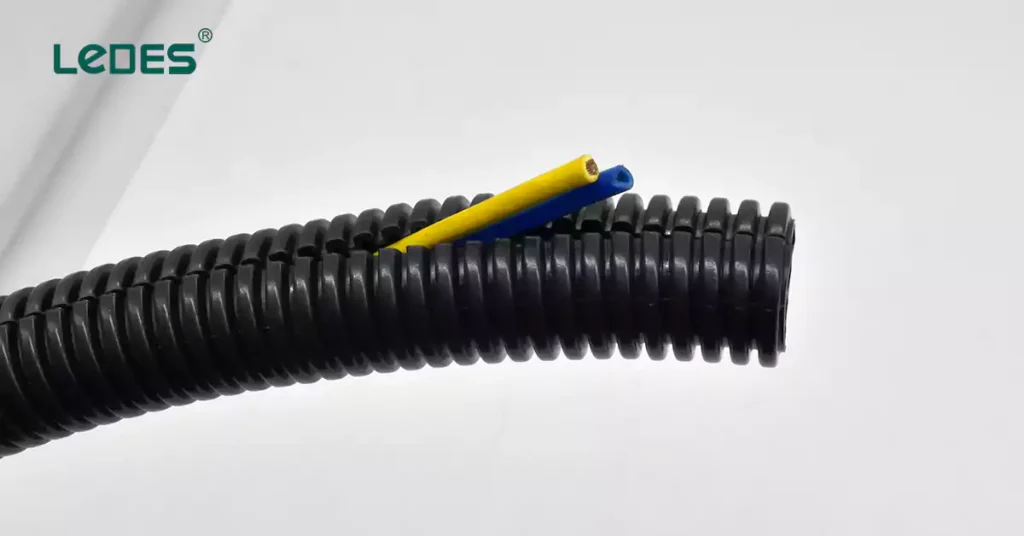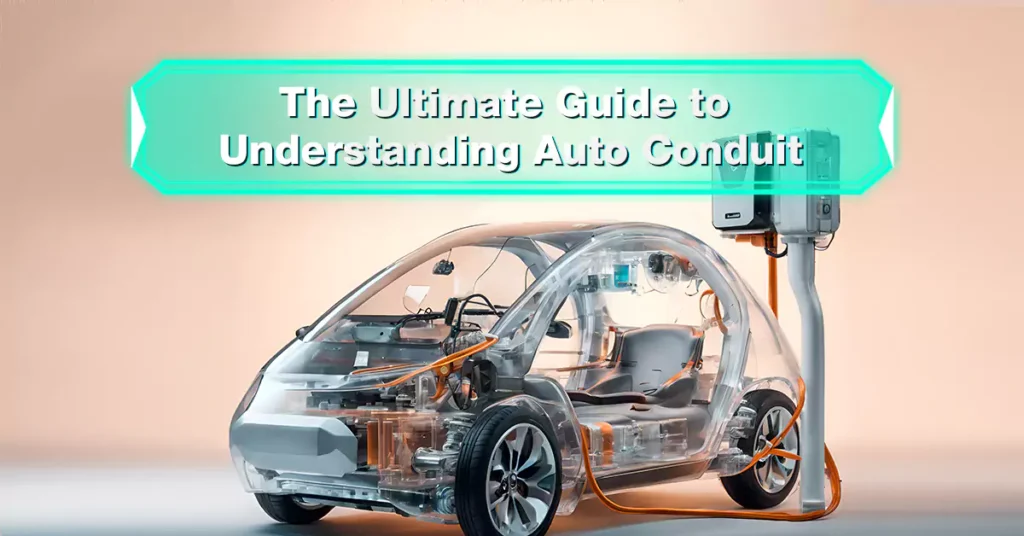
Inhaltsverzeichnis
Mit der rasanten Entwicklung der Elektrofahrzeugbranche sind Autokabelkanäle allmählich in unser Blickfeld geraten. Als traditioneller Kabelkanallieferant wissen wir, dass Kunststoffkabelkanäle zwar unauffällig aussehen, aber sehr wichtig sind.
In diesem Beitrag werden wir die relevanten Inhalte zu elektrischen Leitungen im Auto ausführlich besprechen. Durch das Lesen können Sie Folgendes erfahren:
Was ist Auto Conduit und wie funktioniert es?
Warum ist ein Auto Conduit für elektrische Systeme wichtig?
Wie wähle ich die richtige Größe für ein Autorohr?
Und mehr. Also, fangen wir an.
Ein Autorohr ist ein Rohr, das zum Schutz und zur Verlegung elektrischer Leitungen in einem Fahrzeug verwendet wird. Autorohre können aus Metall oder Kunststoff bestehen. Die meisten Rohre sind gespaltene, flexible Rohre, für manche Zwecke werden jedoch auch starre Rohre verwendet.
Autorohre und PVC-Elektrorohre sind so konzipiert, dass sie die strengen Leistungsanforderungen der Automobilindustrie erfüllen. Sie schützen interne Kabel vor Stößen, Bakterien, Chemikalien und anderen Formen der Korrosion, insbesondere unter den anspruchsvollen Bedingungen des Motorraums.
Wie wir alle wissen, herrscht in Elektrofahrzeugen oft hohe Spannung. Wenn also die internen Kabel brechen und einen Kurzschluss oder eine kurzzeitige Hochspannung verursachen, kann dies zu potenziellen Risiken für das Auto oder den Fahrer und die Passagiere führen.
Autoelektrikleitungen sind nicht einfach nur Rohre zur Durchführung elektrischer Leitungen. Sie fungieren als Schutzleitungen, die Elektrizität sicher und effizient leiten und gleichzeitig vor einer Vielzahl potenzieller Gefahren schützen. Stellen Sie sie sich als die Arterien des Kreislaufsystems eines Elektroautos vor, die sicherstellen, dass die lebenswichtige Energie ohne Störungen oder Gefahren ihr Ziel erreicht.
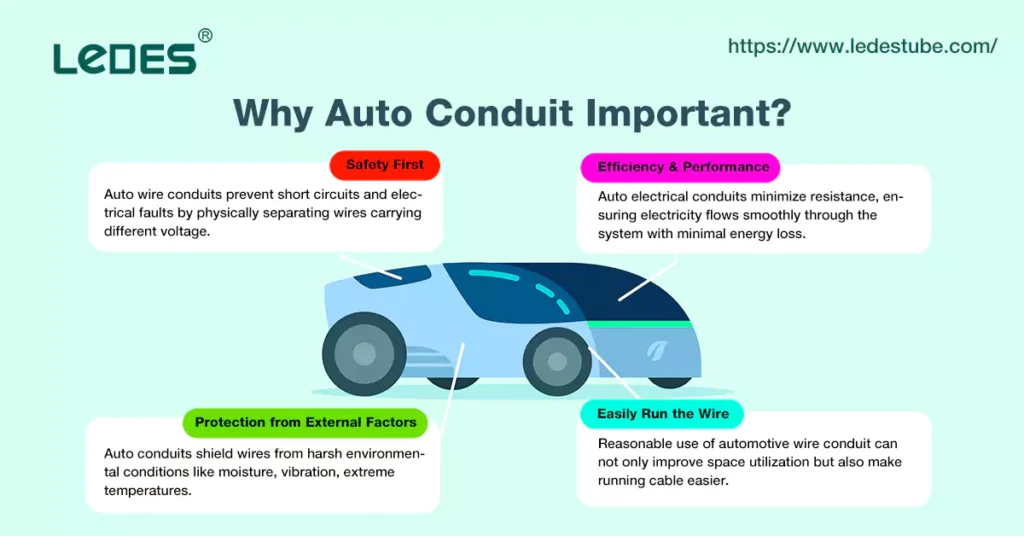
Sicherheit geht vor: Autokabelkanäle verhindern Kurzschlüsse und elektrische Fehler, indem sie Kabel mit unterschiedlichen Spannungen physisch trennen und so das Risiko von Überhitzung, Bränden und Verletzungen verringern. Ein Bericht der National Highway Traffic Safety Administration (NHTSA) aus dem Jahr 2022 hob hervor, dass fehlerhafte Verkabelung ein Faktor bei fast 101 % der Fahrzeugrückrufe im Zusammenhang mit elektrischen Systemen war.
Effizienz und Leistung: Autoelektrik COnduits minimieren den Widerstand und sorgen dafür, dass der Strom reibungslos und mit minimalem Energieverlust durch das System fließt. Dies führt zu verbesserter Leistung und Reichweite für Elektrofahrzeuge, bei denen jedes Watt zählt.
Schutz vor äußeren Einflüssen: Autokabelkanäle schützen Kabel vor rauen Umweltbedingungen wie Feuchtigkeit, Vibrationen, extremen Temperaturen und sogar korrosivem Straßenschmutz. Diese Haltbarkeit ist für die Langlebigkeit und die Aufrechterhaltung einer zuverlässigen elektrischen Leistung über die Zeit unerlässlich.
Verlegen Sie das Kabel ganz einfach. Der Innenraum von Fahrzeugen mit neuer Antriebstechnologie ist kompakt, insbesondere der Motorraum oder die Karosserie. Der sinnvolle Einsatz von Kabelkanälen für Kraftfahrzeuge kann nicht nur die Raumausnutzung verbessern, sondern auch die Verlegung von Kabeln erleichtern. Selbst bei Reparaturen oder Wartungsarbeiten können Kabel einfach hinzugefügt oder entfernt werden, wodurch die Kabel schöner aussehen und potenzielle Risiken vermieden werden.
Nach einem Aufsehen erregenden Brandvorfall mit einem Tesla Model 3 im Jahr 2019 ergaben Untersuchungen, dass der Brand von einem Batteriemodul unter dem Boden ausging und möglicherweise durch eine fehlerhafte Isolierung der Verkabelung verschlimmert wurde. Dieser Fall unterstreicht die entscheidende Bedeutung robuster Leitungen zur Eindämmung und Minderung potenzieller elektrischer Gefahren in Elektrofahrzeugen.
„Leitungen sind nicht nur passive Leitungen; sie tragen aktiv zur Sicherheit, Leistung und Zuverlässigkeit von Elektrofahrzeugen bei“, erklärt Dr. Emily Chen, Automotive Electrification Specialist bei der Society of Automotive Engineers (SAE). „Die verwendeten Materialien und die Konstruktionsprinzipien bei der Entwicklung von Autoleitungen sind entscheidend für eine sichere und effiziente Mobilität der Zukunft.“
Da Elektrofahrzeuge immer komplexer werden, werden wir in Zukunft noch ausgefeiltere Leitungen sehen mit:
Integrierte Sensoren: Zur Echtzeitüberwachung und Zustandsbewertung.
EMI-Abschirmung: Zum Schutz empfindlicher elektronischer Systeme vor elektromagnetischen Störungen.
Leichte Materialien: Um zur Reduzierung des Gesamtgewichts des Fahrzeugs beizutragen.
Die Zukunft der Autoverkabelung ist eng mit der Zukunft der Elektrofahrzeuge verknüpft. Investitionen in Forschung und Entwicklung in diesem Bereich sind von entscheidender Bedeutung, um Innovationen voranzutreiben, die Sicherheit zu verbessern und einen nahtlosen Übergang zu einer nachhaltigeren Verkehrslandschaft zu gewährleisten.
Bei der Auswahl der richtigen Auto-Kabelkanalgröße geht es nicht nur darum, Kabel in ein Rohr zu quetschen; es geht auch darum, eine effiziente Stromversorgung, optimale Leistung und vor allem Sicherheit sicherzustellen.
Eine schlecht dimensionierte Leitung kann zu Überhitzung oder verringerter Energieübertragung führen oder sogar Brandgefahr bergen – Konsequenzen, mit denen kein Fahrzeugbesitzer konfrontiert werden möchte.
Die Dimensionierung automatischer Leitungen hängt von mehreren Schlüsselfaktoren ab:
Aktueller Verbrauch: Die Menge des durch die Drähte fließenden elektrischen Stroms bestimmt die erforderliche Leitungsgröße. Höhere Ströme erfordern größere Leitungen, um übermäßige Wärmeentwicklung zu verhindern und sichere Betriebstemperaturen aufrechtzuerhalten.
Drahtstärke: Je dicker (niedrigere Querschnittsnummer) der Draht ist, desto mehr Strom kann er verarbeiten, was sich auf den erforderlichen Leitungsdurchmesser auswirkt.
Anzahl der Drähte: Mehrere in einem Kabelkanal gebündelte Drähte erhöhen den internen Volumenbedarf. Überfüllung führt zu Problemen bei der Wärmeableitung und verringerter Luftzirkulation.
Umgebungsbedingungen: Bei extremen Temperaturen oder der Einwirkung rauer Elemente sind größere Leitungen erforderlich, um eine mögliche Ausdehnung/Kontraktion der Kabel aufzunehmen und eine Verschlechterung der Isolierung zu verhindern.
Die übliche Größe von Autoelektrikrohren liegt zwischen 9 mm und 30 mm (1/4 Zoll bis 1 Zoll) und wird im Autoinnenraum verwendet.
Größe (Außendurchmesser) | Typische Anwendungen |
9 mm (1/4 Zoll) | Schwachstromkreise, Sensorverkabelung, Zusatzscheinwerfer |
12 mm (3/8 Zoll) | |
16 mm (1/2 Zoll) | Allgemeine Verwendung, Kabelbäume mit kleinerem Durchmesser, Instrumententafelverkabelung |
20 mm (5/8 Zoll) | |
24 mm (3/4 Zoll) | Hochstromanwendungen, Anlasserverkabelung, Zündsysteme |
30 mm (1 Zoll) |
Wenn Sie über die elektrische Leitung der Ladestation sprechen, ist die Größe die gleiche wie die elektrische Leitung des Gebäudes. Nehmen wir die USA und Kanada als Beispiel.
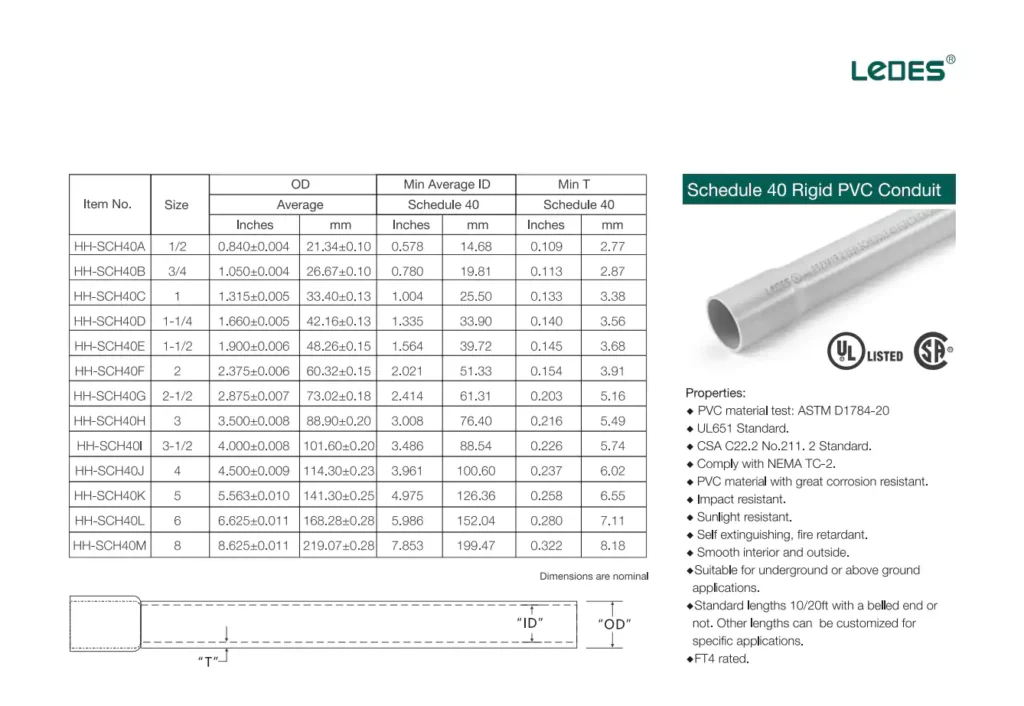
Zeitplan 40 Conduit Handelsgröße (USA)
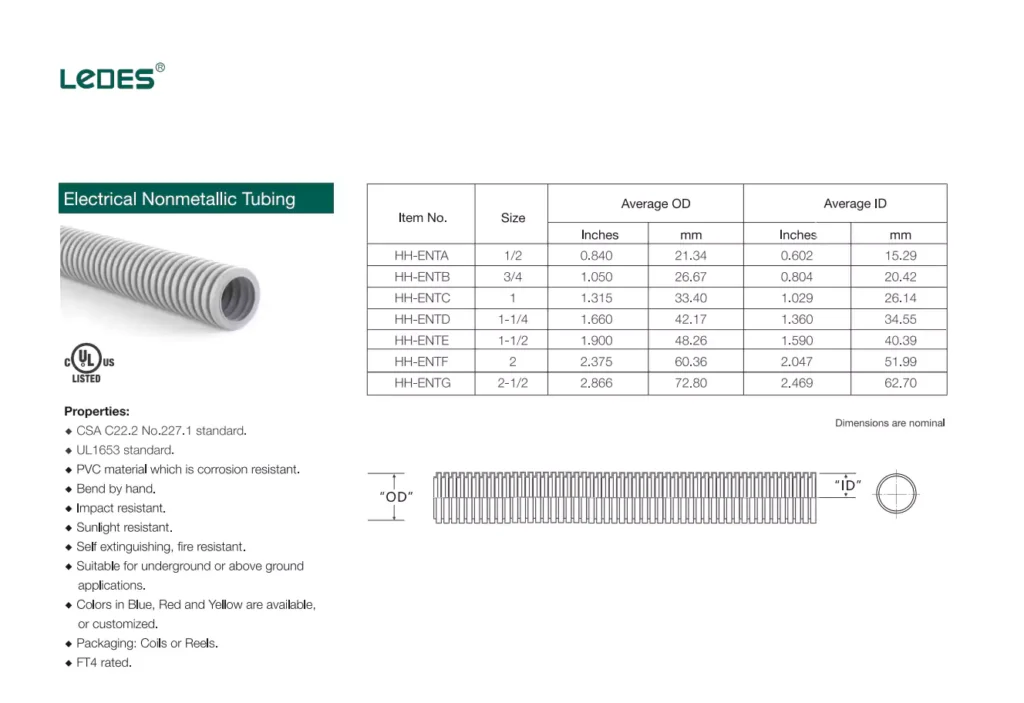
HNO-Leitung Handelsgröße (Kanada)
Unterdimensionierte Leitung: Kann zu Überhitzung, Isolationsschäden und sogar Bränden aufgrund übermäßiger Hitzeentwicklung führen. Dies stellt ein ernstes Sicherheitsrisiko dar und kann zu kostspieligen Reparaturen oder Unfällen führen.
Übergroßer Kanal: Dies erscheint zwar besser, kann jedoch zu unnötigen Materialkosten, Gewichtserhöhungen und möglichen Beeinträchtigungen des Fahrzeugdesigns führen.
Der für seine beeindruckende Leistung bekannte Roadster von Tesla verwendet Hochleistungsladesysteme, die einen erheblichen Stromfluss erfordern. Die Ingenieure wählten sorgfältig Leitungen mit geeigneten Durchmessern aus, um diese hohen Ströme ohne Kompromisse bei Sicherheit oder Effizienz bewältigen zu können. Eine zu geringe Dimensionierung hätte die Ladegeschwindigkeit erheblich beeinträchtigt und eine Brandgefahr dargestellt.
„Die Wahl der richtigen Leitungsgröße ist wie die Suche nach dem perfekten Puzzleteil“, erklärt John Smith, leitender Elektroingenieur bei der Automotive Wire Products Association (AWPA). „Es geht darum, Stromkapazität, Kabelstärke, Umweltfaktoren und das Gesamtdesign des Fahrzeugs in Einklang zu bringen, um optimale Leistung und Sicherheit zu gewährleisten.“
Beratungsressourcen für die Automobilindustrie wie:
Nationaler Elektrocode (NEC):
Bietet Richtlinien für sichere elektrische Installationen in Fahrzeugen.
SAE-Normen:
Bietet spezifische Empfehlungen zur Fahrzeugverkabelung und zur Dimensionierung von Leitungen.
Herstellerspezifikationen:
Informationen zu den genauen Leitungsanforderungen finden Sie stets in den Richtlinien des Fahrzeugherstellers.
Lokaler Code:
Kabelkanäle und PVC-Kanäle liegen nah beieinander. Denn wir müssen nicht nur den Kabelkanal des Autos selbst berücksichtigen, sondern auch die Installation und den Schutz des Kabelkanals der Superschnellladestation.
Nehmen wir Nordamerika als Beispiel. Der aktuelle UL 651-Standard in den Vereinigten Staaten (anwendbar auf starre PVC-Rohre) oder UL 1653 oder CSA C22.2 Die Normen Nr. 227.1:19 für HNO-Leitungen sind alle Spezifikationen, die eingehalten werden müssen. Gleichzeitig ist auch die Feuerbeständigkeit ein Faktor, auf den man sich konzentrieren muss. Dann ist es sehr wichtig, über UL94 V-0- oder FT4-bezogene Tests und Zertifizierungen zu verfügen.
Wenn Sie die Faktoren verstehen, die die Leitungsgröße beeinflussen, und Industrienormen nutzen, können Sie sicherstellen, dass die elektrische Anlage Ihres Autos sicher, effizient und zuverlässig funktioniert.
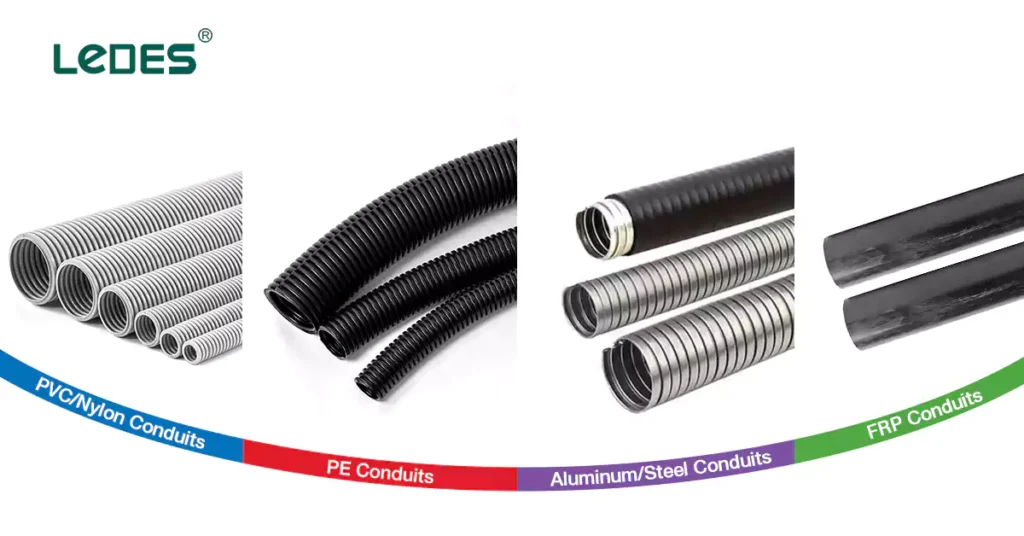
Unter der Motorhaube moderner Fahrzeuge brummt ein komplexes Netzwerk elektrischer Systeme, das von speziellen Leitungen angetrieben wird, die lebenswichtige Ströme sicher und effizient transportieren. Aber wussten Sie, dass diese unbesungenen Helden aus einer Vielzahl von Materialien hergestellt werden, von denen jedes seine eigenen Stärken und Schwächen hat?
Diese vielseitigen Leitungen bieten hervorragende Flexibilität, Schlagfestigkeit und Kosteneffizienz. Sie werden aufgrund ihrer einfachen Installation und Haltbarkeit häufig für Nieder- bis Mittelspannungsanwendungen in Fahrzeugkabelbäumen verwendet.
Fallstudie: Bei Oldtimer-Restaurierungen PVC-Rohr wird oft bevorzugt, da es die ursprüngliche Ästhetik nachahmt und gleichzeitig eine zuverlässige Isolierung für elektrische Komponenten bietet.
PE-Rohre zeichnen sich durch hohe Flexibilität, chemische Beständigkeit und hervorragende dielektrische Eigenschaften aus. Sie eignen sich besonders gut für Automobilanwendungen, bei denen Beständigkeit gegen Feuchtigkeit und Umwelteinflüsse erforderlich ist.
Einem Bericht von Grand View Research aus dem Jahr 2021 zufolge wird der globale Polyethylenmarkt bis 2030 voraussichtlich ein Volumen von $255 Milliarden erreichen, was zum Teil auf die weit verbreitete Verwendung in verschiedenen Branchen, einschließlich der Automobilindustrie, zurückzuführen ist.
Obwohl sie schwerer sind als ihre Gegenstücke aus Thermoplast, bieten metallische Leitungen eine bessere elektrische Leitfähigkeit und Abschirmung gegen elektromagnetische Störungen (EMI). Sie werden häufig in Hochspannungsanwendungen oder dort eingesetzt, wo EMI-Schutz von entscheidender Bedeutung ist, wie etwa in Batteriesystemen für Elektrofahrzeuge.
Fallstudie:
Das Model S Plaid von Tesla verwendet Aluminiumrohre, um die erheblichen Ströme zu leiten, die in seinem elektrischen Hochleistungsantriebsstrang fließen, und sorgt so für eine sichere und effiziente Leistungsabgabe.
FRP-Rohre vereinen Festigkeit, geringes Gewicht und hervorragende Korrosionsbeständigkeit und sind daher ideal für Anwendungen geeignet, die rauen Umgebungen ausgesetzt sind oder eine lange Lebensdauer erfordern.
„Für Elektrofahrzeuge, die in extremen Klimazonen oder im Gelände eingesetzt werden, bieten FRP-Rohre eine robuste Lösung, die anspruchsvollen Umweltfaktoren standhält“, erklärt David Lee, Werkstoffingenieur am Automotive Innovation Center.
Die Zukunft der Autokabelleitungsmaterialien wird wahrscheinlich Folgendes bringen:
Verstärkter Einsatz nachhaltiger und recycelter Materialien.
Entwicklung von Verbundwerkstoffen mit verbessertem Festigkeits-Gewichts-Verhältnis.
Integration intelligenter Sensortechnologien für Echtzeitüberwachung und -diagnose.
Die Wahl des richtigen Materials für Ihren spezifischen Einsatzzweck ist entscheidend für die Gewährleistung von Sicherheit, Leistung und Langlebigkeit. Wenn Sie die Eigenschaften und Einsatzmöglichkeiten der einzelnen Materialien kennen, können Sie fundierte Entscheidungen hinsichtlich der elektrischen Infrastruktur Ihres Fahrzeugs treffen.
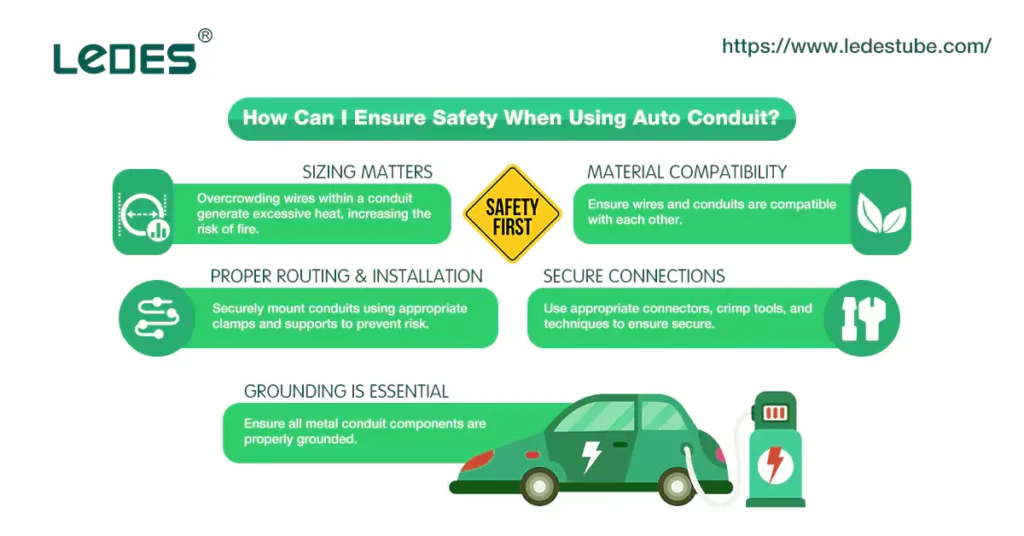
Autokabelkanäle sind die heimlichen Helden des elektrischen Systems Ihres Fahrzeugs und sorgen für eine sichere und effiziente Stromversorgung. Doch wie bei allen wichtigen Komponenten kann eine unsachgemäße Handhabung oder Installation schwerwiegende Folgen haben.
Die Sicherheit muss bei der Arbeit mit Autoleitungen unbedingt an erster Stelle stehen. Hier ist eine Übersicht über die wichtigsten Vorgehensweisen:
Wenn zu viele Drähte in einem Kabelkanal verlegt werden, entsteht übermäßige Hitze, was die Gefahr von Isolationsfehlern und möglichen Bränden erhöht. Zu kleine Kabelkanäle können ebenfalls zu Überhitzung und Beschädigung führen.
Nach Angaben der National Fire Protection Association (NFPA) sind elektrische Fehlfunktionen in den USA jährlich für schätzungsweise 46.000 Hausbrände verantwortlich. Dies unterstreicht die Bedeutung einer richtigen Dimensionierung.
Stellen Sie sicher, dass Kabel und Leitungen miteinander kompatibel sind, und berücksichtigen Sie dabei Faktoren wie Nennspannung, Temperaturbeständigkeit und chemische Verträglichkeit.
Eine fehlerhafte Installation mit inkompatiblen Leitungsmaterialien führte zu einem Isolationsdurchschlag im Verkabelungssystem eines Oldtimers, was während des Betriebs einen Brand verursachte. Beachten Sie hinsichtlich der Kompatibilitätsrichtlinien immer die Herstellerspezifikationen.
Verwenden Sie geeignete Steckverbinder, Crimpwerkzeuge und Techniken, um sichere, vibrationsfeste Verbindungen innerhalb des Rohrs sicherzustellen. Lose Verbindungen können zu Lichtbögen, Kurzschlüssen oder sogar zu einem vollständigen Stromkreisausfall führen.
Industriestandard: Der SAE (Gesellschaft der Automobilingenieure) bietet detaillierte Standards für die Konstruktion und Installation von elektrischen Steckverbindern in Fahrzeugen.
Verlegen Sie Leitungen nicht in der Nähe von Wärmequellen, scharfen Kanten und Bereichen, die starken Vibrationen ausgesetzt sind. Befestigen Sie Leitungen mit geeigneten Klemmen und Halterungen sicher, um Bewegungen und mögliche Schäden an den Kabeln zu verhindern.
Stellen Sie sicher, dass alle metallischen Leitungskomponenten ordnungsgemäß geerdet sind, um einen sicheren Pfad für Fehlerströme bereitzustellen und so das Risiko eines Stromschlags oder einer Verletzung zu minimieren.
„Bei der Arbeit mit Autoleitungen sollte die Sicherheit immer an erster Stelle stehen“, betont Mary Johnson, leitende Elektroingenieurin am Automotive Safety Institute. „Die Einhaltung von Industrienormen, die Verwendung geeigneter Materialien und Techniken sowie die Priorisierung sicherer Verbindungen sind entscheidende Schritte zur Vermeidung potenzieller Gefahren.“
Überprüfen Sie das Leitungssystem Ihres Fahrzeugs regelmäßig auf Anzeichen von Verschleiß, Beschädigungen oder losen Verbindungen.
Wenden Sie sich bei komplexen Verkabelungs- oder Leitungsreparaturen an einen qualifizierten Elektriker.
Durch die Einhaltung dieser Sicherheitsmaßnahmen können Sie sicherstellen, dass Ihre Autoleitungen zuverlässig funktionieren und sowohl Ihr Fahrzeug als auch Sie selbst vor elektrischen Gefahren schützen. Denken Sie daran: Sicherheit ist nicht nur eine Priorität, sie ist die Grundlage für ein sicheres und angenehmes Fahrerlebnis.
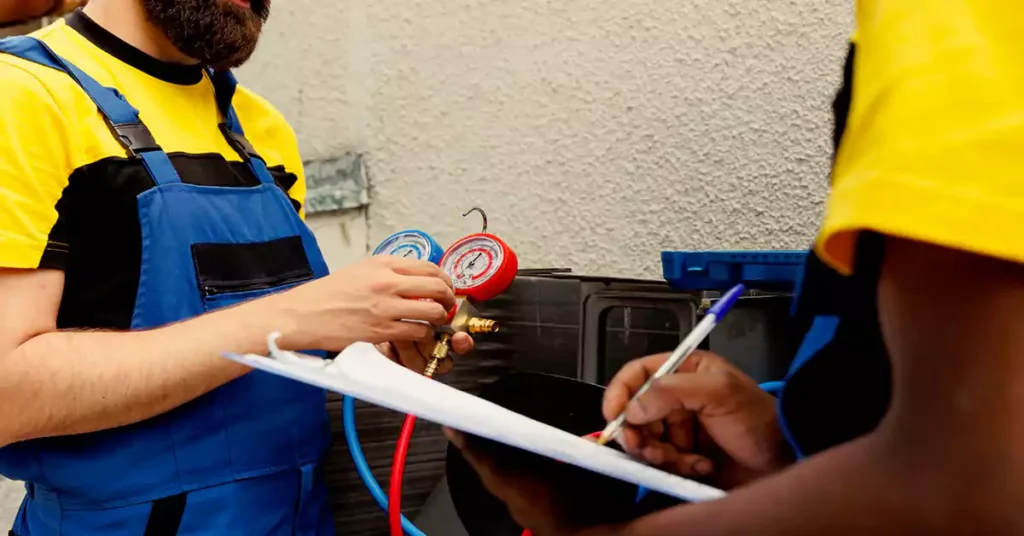
Stellen Sie sich Ihr Autokabelsystem als den heimlichen Helden der elektrischen Infrastruktur Ihres Fahrzeugs vor. Obwohl es oft unter der Motorhaube versteckt ist, spielt es eine wichtige Rolle bei der sicheren Stromversorgung aller Komponenten. Wie bei jedem kritischen System sorgt regelmäßige Wartung für optimale Leistung und Langlebigkeit.
Die Vernachlässigung Ihres Leitungssystems kann zu Überhitzung, Kurzschlüssen, Fehlfunktionen und sogar Bränden führen – Konsequenzen, die kein Autofahrer ertragen möchte. So halten Sie die Leitungen Ihres Autos reibungslos am Laufen:
Überprüfen Sie Leitungen regelmäßig auf Anzeichen von Verschleiß, Beschädigungen (Risse, Schnitte, Abschürfungen), lose Verbindungen oder übermäßige Hitzeentwicklung. Eine frühzeitige Erkennung ist entscheidend, um spätere schwerwiegende Probleme zu vermeiden.
Fallstudie: Ein Bericht der National Highway Traffic Safety Administration (NHTSA) aus dem Jahr 2019 hob hervor, dass ein ausgefranster Kabelbaum, der zu freiliegenden Kabeln in einem Kabelkanal führte, zu einem Fahrzeugbrand beitrug.
Untersuchen Sie die Anschlüsse auf Korrosion, Lockerheit oder Anzeichen von Überhitzung. Ziehen Sie alle losen Verbindungen fest an und ersetzen Sie beschädigte Anschlüsse bei Bedarf.
Industriestandard: Die SAE (Society of Automotive Engineers) bietet spezifische Richtlinien für die Installation und Wartung von Steckverbindern, um sichere und zuverlässige Verbindungen zu gewährleisten.
Überprüfen Sie die Leitungen auf Stellen, an denen sie an scharfen Kanten, beweglichen Teilen oder anderen Komponenten reiben. Verwenden Sie Schutzhüllen, Polster oder passen Sie die Verlegung an, um Reibung zu minimieren und Schäden an der Isolierung zu vermeiden.
Eine Studie der Society of Automotive Engineers (SAE) ergab, dass eine unsachgemäße Verlegung von Leitungen eine häufige Ursache für Verkabelungsfehler in Fahrzeugen ist, was zu elektrischen Fehlfunktionen und potenziellen Sicherheitsrisiken führt.
Übermäßige Hitze kann Leitungsmaterial und Isolierung beschädigen. Achten Sie in der Nähe von Hochstromkomponenten oder in Bereichen mit schlechter Belüftung auf Anzeichen von Überhitzung.
Expertenmeinung:
„Eine regelmäßige Überprüfung auf Temperaturschwankungen rund um Leitungen ist unerlässlich“, erklärt Dr. Emily Chen, leitende Werkstoffingenieurin bei der Automotive Industry Association (AIA). „Hohe Temperaturen können die Lebensdauer des Materials erheblich beeinträchtigen und zu vorzeitigen Ausfällen führen.“
Wenden Sie sich bei komplexen Reparaturen, der Behebung elektrischer Probleme oder bei Unsicherheiten hinsichtlich der Wartung von Leitungen an einen qualifizierten Elektriker mit Spezialisierung auf Fahrzeugsysteme.
Proaktive Wartung spart Ihnen auf lange Sicht:
Indem Sie diese Praktiken in Ihre Fahrzeugpflegeroutine integrieren, können Sie teure Reparaturen vermeiden, einen sicheren Betrieb gewährleisten und die Lebensdauer Ihres Autoleitungssystems verlängern. Denken Sie daran: Ein wenig vorbeugende Pflege trägt viel dazu bei, dass Ihre Fahrt reibungslos und sicher läuft.
Das Auto Conduit-System Ihres Fahrzeugs fungiert als stiller Wächter des elektrischen Netzwerks und leitet den Strom sicher und effizient. Aber wie bei jedem komplexen System kann es manchmal zu Problemen kommen. Wenn Sie wissen, wie Sie diese Probleme beheben können, können Sie sich Kopfschmerzen, Reparaturkosten und sogar potenzielle Gefahren ersparen.
Hier ist Ihr Leitfaden zur Diagnose und Behebung häufiger Probleme mit Autoleitungen:
Der erste Schritt besteht darin, die Anzeichen zu erkennen. Achten Sie auf flackernde Lichter, durchgebrannte Sicherungen, Fehlfunktionen elektrischer Komponenten oder ungewöhnliche Geräusche (Summen, Knistern) in der Nähe der Leitungen.
Eine Studie der AAA ergab, dass fehlerhafte Verkabelungen und Probleme mit der Elektrik jährlich für über 201.000.000 Fahrzeugreparaturansprüche verantwortlich sind, was die Häufigkeit von Problemen mit Leitungen unterstreicht.
Untersuchen Sie Leitungen gründlich auf Risse, Schnitte, lose Verbindungen, Scheuerstellen oder Anzeichen einer Überhitzung.
Fallstudie: Ein Kunde berichtete von intermittierenden Warnleuchten am Armaturenbrett und einem nicht funktionierenden elektrischen Fensterheber. Bei der Inspektion entdeckte ein Techniker einen Nagetierbiss an einer Autoleitung in der Nähe des Motorraums, wodurch der Stromfluss unterbrochen wurde.
Überprüfen Sie die Anschlüsse auf Korrosion, lose Drähte oder Beschädigungen der Stifte. Verwenden Sie ein Multimeter, um die Spannungskontinuität an jedem Anschlusspunkt zu testen.
Industriestandard: Die SAE (Society of Automotive Engineers) stellt in ihren Normen für die Fahrzeugverkabelung detaillierte Richtlinien für die Inspektion und Testverfahren von Steckverbindern bereit.
Stellen Sie sicher, dass alle metallischen Leitungskomponenten mit einem Erdungsband oder -bolzen sicher geerdet sind. Verwenden Sie ein Multimeter, um die Erdungskontinuität zu überprüfen, indem Sie eine Sonde auf die Leitung und die andere auf einen bekannten Erdungspunkt legen.
Expertenmeinung:
„Eine ordnungsgemäße Erdung ist für die Sicherheit von entscheidender Bedeutung“, erklärt John Smith, leitender Elektroingenieur am Automotive Safety Institute. „Eine fehlerhafte Erdung kann zu Stromschlägen oder sogar zu Schäden an elektronischen Komponenten führen.“
Untersuchen Sie den Kabelbaum im Kabelkanal sorgfältig auf gebrochene Litzen, ausgefranste Isolierung oder eingeklemmte Drähte. Ersetzen Sie alle beschädigten Abschnitte des Kabelbaums.
Bei komplexen Problemen oder wenn Sie sich nicht sicher sind, wie Sie elektrische Probleme selbst diagnostizieren und reparieren, wenden Sie sich an einen qualifizierten Autoelektriker. Diese verfügen über das Fachwissen und die Werkzeuge, um das Problem genau zu lokalisieren und eine sichere Reparatur zu gewährleisten.
Wenn Sie diese Schritte zur Fehlerbehebung befolgen, können Sie häufige Probleme mit Autoleitungen sicherer lösen. Denken Sie daran: Durch schnelles Handeln können Sie verhindern, dass sich kleinere Probleme zu großen Problemen und potenziellen Sicherheitsrisiken entwickeln.
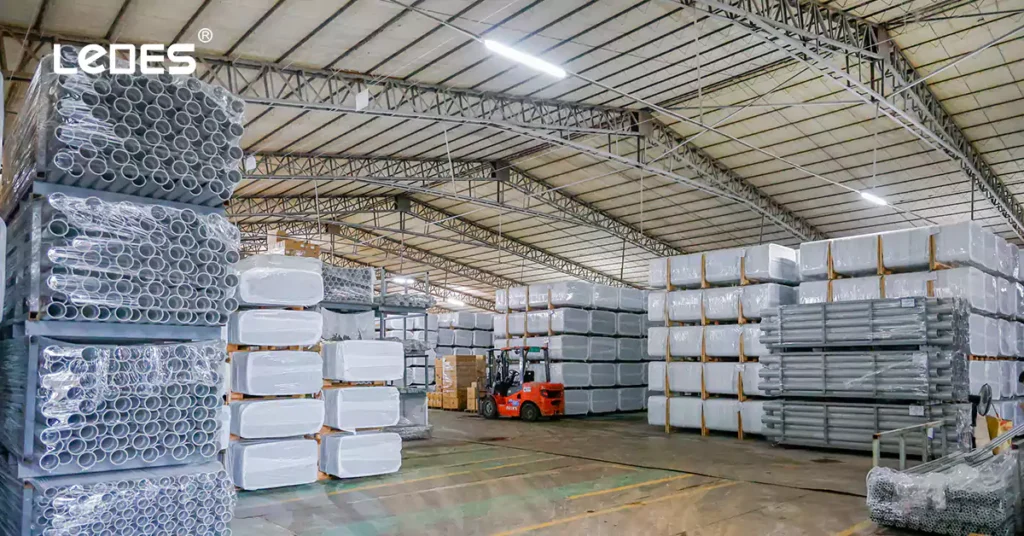
Wenn es um das elektrische System Ihres Fahrzeugs geht, ist Zuverlässigkeit von größter Bedeutung. Die Auswahl der richtigen Lieferant von elektrischen Leitungen für Autos kann den Unterschied zwischen einem reibungslos laufenden Motor und einem potenziellen Albtraumszenario ausmachen.
So navigieren Sie auf dem Markt und finden einen Lieferanten, der Ihr Vertrauen verdient:
Suchen Sie nach Lieferanten mit nachweislicher Erfolgsbilanz in der Automobilindustrie. Jahrelange Erfahrung bedeutet ein tiefes Verständnis der Materialeigenschaften, anwendungsspezifischer Anforderungen und sich entwickelnder Industriestandards.
Fallstudie: Ein renommiertes Motorsportteam wechselte für seine Rennfahrzeuge zu einem neuen Leitungslieferanten. Der Wechsel führte zu einer verbesserten Leitfähigkeit und höheren Temperaturbeständigkeit, was zu einer deutlichen Leistungssteigerung bei Wettbewerbsveranstaltungen beitrug.
Fordern Sie Qualitätssicherung: Fordern Sie Zertifizierungen wie ISO 9001 (Qualitätsmanagement), AS9100 (Luftfahrt) oder branchenspezifische Automobilstandards. Diese zeugen von unserem Engagement für Qualitätskontrolle und Materialintegrität.
Ein Bericht der American Automotive Association (AAA) hob hervor, dass die Verwendung nicht konformer Materialien bei Fahrzeugreparaturen zu Fehlfunktionen, Sicherheitsrisiken und kostspieligen Reparaturen führen kann.
Prüfen Sie, ob der Lieferant eine große Auswahl an Rohrtypen (PVC, Nylon, Metall usw.) und Größen anbietet, die Ihren speziellen Anforderungen entsprechen.
Expertenmeinung:
„Ein seriöser Lieferant wird verstehen, dass es keine Einheitslösung gibt“, sagt Sarah Johnson, leitende Ingenieurin bei Auto Wire Solutions. „Er sollte Anpassungsoptionen für einzigartige Anwendungen und Fahrzeugmodelle anbieten.“
Suchen Sie nach Lieferanten, die schnellen Kundenservice, technischen Support und leicht zugängliche Ressourcen (z. B. Anwendungsleitfäden, Installationsanleitungen) bieten.
Fallstudie: Eine kleine Reparaturwerkstatt lobte einen bestimmten Lieferanten von Autokabelkanälen für dessen außergewöhnliche technische Unterstützung bei der Fehlersuche bei einem komplexen Verkabelungsproblem, wodurch sie letztlich wertvolle Zeit und Ressourcen sparte.
Vergleichen Sie Angebote mehrerer Anbieter und berücksichtigen Sie dabei den Gesamtwert, nicht nur den niedrigsten Preis. Berücksichtigen Sie Lieferzeiten, Lieferoptionen und mögliche Mengenrabatte.
Die Wahl eines zuverlässigen Autokabellieferanten ist eine Investition in die Leistung und Sicherheit Ihres Fahrzeugs. Indem Sie Erfahrung, Qualität, Support und Anpassung priorisieren, stellen Sie sich auf Erfolg und dauerhafte Zuverlässigkeit auf der Straße ein.
Die Automobilindustrie steht an der Schwelle zu einer Revolution, die durch Elektrifizierung, autonomes Fahren und fortschrittliche Konnektivität vorangetrieben wird. Diese rasante Entwicklung erfordert eine Transformation aller Aspekte des Fahrzeugdesigns, einschließlich der oft übersehenen Welt der Kabelkanäle.
Hier ein Blick in die aufregende Zukunft der Autoleitungen:
Da bei Fahrzeugen (insbesondere bei Elektrofahrzeugen) ein höherer Kraftstoffverbrauch und eine höhere Reichweite angestrebt werden, werden Leichtbaumaterialien wie Kohlenstofffaserverbundstoffe, glasfaserverstärkte Kunststoffe (FRP) und sogar moderne Polymere immer häufiger zum Einsatz kommen.
Fallstudie: In den Kabelbäumen des Model S Plaid von Tesla wird eine Kombination aus Aluminium und Verbundwerkstoffen verwendet. Dadurch wird das Gewicht deutlich reduziert, ohne dass die Festigkeit oder Leitfähigkeit beeinträchtigt wird.
Ein Bericht von Grand View Research aus dem Jahr 2023 geht davon aus, dass der weltweite Markt für Automobilsensoren bis 2030 $169 Milliarden erreichen wird, und unterstreicht die zunehmende Integration von Sensortechnologien in Fahrzeuge.
Integration von Sensoren: Zukünftige Leitungen könnten eingebettete Sensoren zur Echtzeitüberwachung von Temperatur, Druck, Vibration und sogar elektrischem Stromfluss enthalten. Diese Daten können helfen, potenzielle Ausfälle vorherzusagen, die Leistung zu optimieren und eine proaktive Wartung zu ermöglichen.
Stellen Sie sich eine Autoleitung vor, die kleinere Schäden selbstständig reparieren kann! Die Forschung an selbstheilenden Materialien schreitet schnell voran und bietet das Potenzial für verbesserte Haltbarkeit und längere Lebensdauer.
Expertenmeinung:
„Die Zukunft der Autoleitungen liegt in der intelligenten Integration“, sagt Dr. Emily Chen, leitende Werkstoffingenieurin bei der Automotive Industry Association (AIA). „Selbstheilungsfähigkeiten könnten Wartungsabläufe revolutionieren und die Sicherheit deutlich verbessern.“
Kabelloses Laden ist bei Smartphones und anderen Geräten bereits weit verbreitet. Diese Technologie bietet enormes Potenzial für Fahrzeuge, da sie physische Verbindungen zwischen Batterie und elektrischen Komponenten überflüssig macht, den Kabelsalat reduziert und die Gesamteffizienz verbessert.
Fallstudie: Unternehmen wie Local Motors testen bereits den 3D-Druck, um maßgeschneiderte Leitungen für bestimmte Fahrzeugmodelle und Anwendungsanforderungen herzustellen. Dies eröffnet Möglichkeiten für mehr Designflexibilität und bedarfsgerechte Fertigung.
Die Zukunft der Autoleitungen verspricht einen dynamischen Wandel hin zu intelligenteren, leichteren und widerstandsfähigeren Systemen, die letztendlich zu sichereren, effizienteren und technologisch fortschrittlicheren Fahrzeugen beitragen.
Dank der rasanten Entwicklung von Elektrofahrzeugen hat sich die Autoverkabelung von einer unbeachteten Verkabelungsreihe zu der gegenwärtig rasanten Entwicklung entwickelt.
Es funktioniert lange Zeit in rauen Umgebungen, daher ist seine Leistung sehr wichtig. Derzeit hat AAA auch entsprechende Standards festgelegt. In diesem Artikel haben wir auch erwähnt, wie man die richtige elektrische Leitung für Autos auswählt, Typ, Material usw. und wie man sie während des Gebrauchs wartet.
Dies ist alles für diesen Beitrag. Wenn Sie noch Fragen haben, können Sie ein Formular ausfüllen oder eine E-Mail an unsere Experten senden, die spezifische Lösungen mit Ihnen besprechen.


